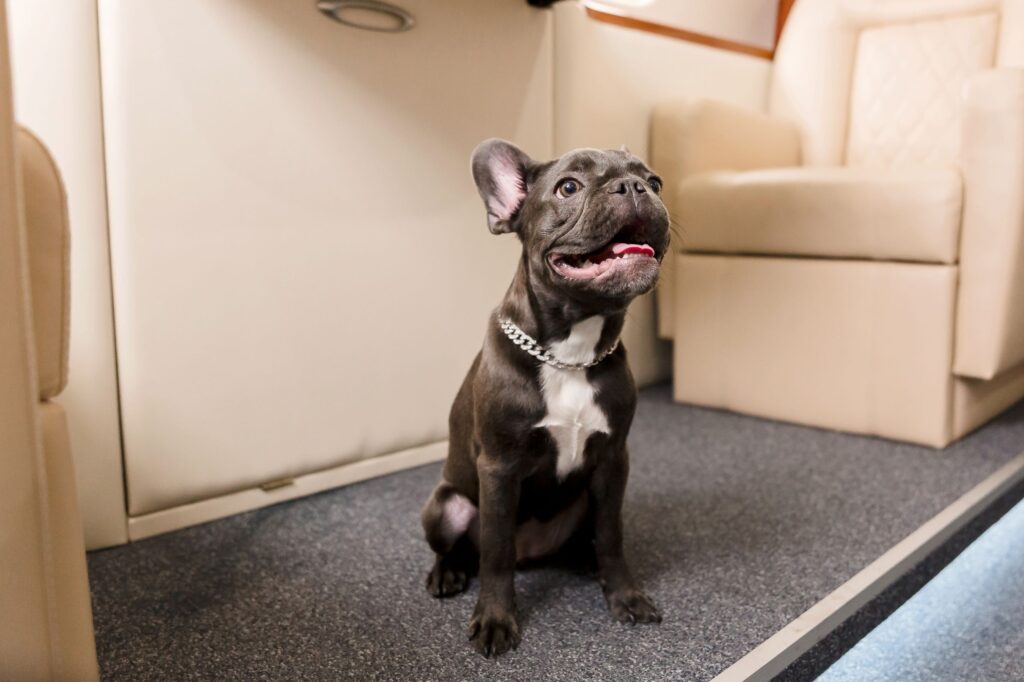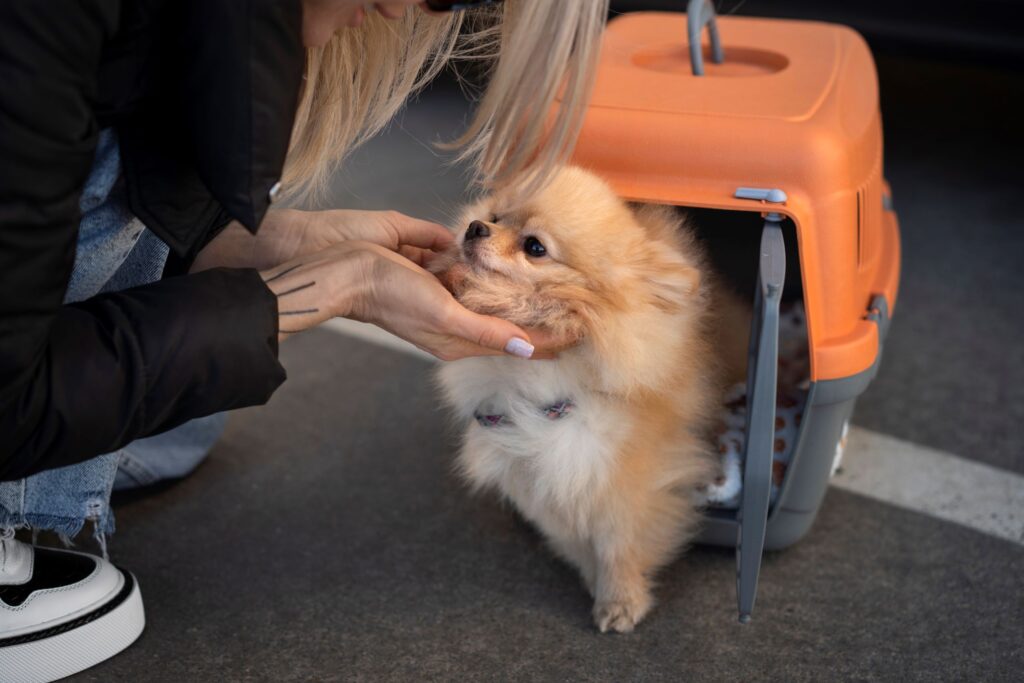
Private Jet Travel with Animals: A Pet Owner’s Guide
Taking your pet on a trip can be exciting, but it can also be tricky. Whether you choose a commercial flight or a private jet, knowing your options is important for a smooth journey for you and your furry friend. This guide will help you understand the rules and regulations for travelling with pets on airplanes, so you can make the best choice for your next adventure together with your four-legged friend.
Pets on Private Jets and Commercial Air Travel
Taking your pet on a trip can be exciting, but it can also be tricky. Whether you choose a commercial flight or a private jet, knowing your options is important for a smooth journey for you and your furry friend. This guide will help you understand the rules for travelling with pets on private jets and on commercial airlines, so you can make the best choice for your next adventure together.
Pet Travel on Commercial Flights: What You Need to Know
Travelling with pets on commercial flights can be a complex experience for both animals and their owners, understanding the guidelines is crucial for smooth planning. The International Air Transport Association (IATA) offers valuable guidance to help pet owners through this process. Understanding these rules is key to a smooth journey for both you and your pet.
It’s vital to check your airline’s specific pet policies well in advance, as those policies can differ per airline. In most cases, small pets are allowed to fly in the cabin. Larger pets however, usually need to travel in a suitable airline-approved carrier that’s matching with the size of your pet. Get your furry friend used to the carrier well before the trip.

When compared to bringing your pet on board a private jet, the key disadvantages of travelling with pets on a commercial flight are:
- Limited cabin space for pets
- Potential separation from owners during flight
- Exposure to unfamiliar environments and noises
- Stricter regulations and documentation requirements
- Less flexibility in flight schedules and routes
Pet Travel on Private Flights: What Are The Advantages
Private jet travel has revolutionized the way pet owners can transport their beloved companions. Gone are the days of stressful commercial flights where pets are relegated to cargo holds or cramped carriers under seats. With private aviation, pets can enjoy a luxurious and comfortable journey alongside their owners. This mode of transportation offers a host of advantages that cater specifically to the needs of both pets and their human companions.

Private jet travel offers numerous benefits for pet owners compared to commercial air travel:
- Reduced Stress: Your pet stays with you throughout the journey, minimizing separation anxiety.
- Comfort: Spacious cabins provide a more comfortable environment for your pet.
- Flexibility: Customize your travel schedule to suit your pet’s needs.
- Direct Routes: Avoid layovers and reduce travel time, benefiting both you and your pet.
- Personalized Care: Crew members can provide individualized attention to your pet’s needs.
These advantages make pets on private jets an attractive option for pet owners who prioritize their animal companions’ wellbeing and comfort during journeys. The personalized experience and reduced stress factors contribute to a more enjoyable travel experience for both pets and their owners.
Pets on Private Jets Rules and Requirements
When travelling with pets on private jets or other animals between countries, it’s crucial to be aware of the rules and requirements to ensure a smooth journey. These regulations are designed to protect both the animal and human health, as well as to maintain proper documentation for cross-border travel.
Travelling within the EU
Travelling with a dog, cat or ferret within the European Union is relatively straightforward, thanks to harmonised rules across the 27 EU member states, Norway and Northern Ireland. Although exceptions may apply to or between specific countries, the general requirements remain the same for most.
- Microchip: Your pet must have a registered transponder chip implanted for identification purposes. You can easily check if the microchip is registered correctly by looking up the transponder code on Europetnet or PetMaxx. You can also ask your veterinarian to check this for you during the next consult.
- Rabies Vaccination: Your pet must have a valid anti-rabies vaccination, meaning that the vaccine has been provided and administered by an authorised veterinarian at least 21 days before travel.
- Tapeworm Treatment (dogs only): Dogs must have received a treatment against the fox tapeworm provided by an authorised veterinarian at least 24 hours but not earlier than 5 days before travel. The treatment must be stated in the dog’s pet passport.
- Pet Passport: All pets must travel with a valid European pet passport.
Travelling within the European Union with your pet?
Please refer to the europa.eu website for the latest information about the current regulations. On this website, you can also check on the specific regulations that apply to all EU and Non-EU countries to ensure that you won’t miss out on anything.
Travelling to Great Britain
The United Kingdom’s departure from the European Union has led to new, stricter rules for pet travel. These changes affect pet owners wanting to bring their animals into Great Britain (England, Scotland and Wales). It’s important to understand these rules to ensure a smooth journey for pets and their owners.
Important: Human travelers also require UK ETA authorization for entry, regardless of pet travel. Check out our guide for details: Private Jet Travel Authorisation United Kingdom.

- Approved Breeds (dogs only): By law, it’s prohibited to own dogs of specific breeds in the UK and therefore it’s neither allowed to travel into Great Britain with them.
- Approved Routes and Operators: Only approved operators are allowed to carry pet animals into Great Britain and each individual approved operator is only allowed to carry pets into specific airports.
- Microchip: Your pet must have a registered transponder chip implanted for identification purposes. This chip must have been placed before the rabies vaccination. You can easily check if the microchip is registered correctly by looking up the transponder code on Europetnet or PetMaxx. You can also ask your veterinarian to check this for you during the next consult.
- Rabies Vaccination: Your pet must have a valid anti-rabies vaccination, meaning that the vaccine has been provided and administered by an authorised veterinarian at least 21 days before travel.
- Tapeworm Treatment (dogs only): Dogs must have received a treatment against the fox tapeworm provided by an authorised veterinarian at least 24 hours but not earlier than 5 days before travel. The treatment must be stated in the dog’s pet travel document or health certificate.
- Valid Travel Document: All pets must travel with a valid pet travel document of which the type you need differs per country. Valid types include:
- Pet Passport – mostly applicable to EU member states
- Animal Health Certificate (AHC) – applicable to specific countries
- Pet Health Certificate – applicable to any country
- Declaration Form: You must fill out and submit a form declaring that you will keep ownership of your pet and not transfer the ownership to someone else.
Travelling to Great Britain with your pet?
Please refer to the GOV.UK website for the latest information about the current regulations. On this website, you can also find a step-by-step manual which will provide guidance and ensures that you won’t miss out on anything.
On board Rules
To ensure a safe and comfortable flight for all passengers, crew and pets on board, make sure that you come prepared and bring all required materials. The general rules to simplify this process are:
- Keep your pet in a portable carrier or on a leash unless otherwise permitted by the crew.
- Train your pet to behave well and avoid damaging the crew or aeroplane
- Follow the instructions given by the crew regarding pet movement and feeding during the flight.
- Make sure to inform the crew about any special needs your pet may have during the flight.

Operator-Specific Regulations
Various private jet operators typically apply various regulations. Most operators typically cover these general rules:
- Some operators may have restrictions on the maximum weight of your pet. An operator may have a limitation of 8 kilograms, where another operator may allows pets of over 25 kilograms. Do note that operators may not allow a pet in the cabin that exceeds a certain weight limit.
- Some operators may have restrictions on certain breeds that have increased risk of causing personal harm or injuries.
- Charter operators may limit the number of pets on each flight. The operator’s guidelines or the aircraft’s weight distribution usually decide this maximum number. When travelling with larger pets, the airline might need to reduce the passenger count to accommodate the preferred number of animals.
- Additional fees might apply for pet travel, varying by operator. Some operators may charge 100 euros per pet, while others may charge 500 euros regardless of the number of pets.
Always check with your chosen operator or broker for their specific pet policies before booking.
Tips for a Smooth Journey with Pets on Private Jets
Travelling by private jet offers a luxurious and convenient way to transport your pet. However, to ensure a smooth and stress-free experience, it’s essential to prepare in advance. By following these simple tips, you can make your pet’s private jet journey as comfortable as possible.
- Do a Quick Relief: Before boarding the aircraft, take your pet for a final bathroom break to minimize discomfort during the flight.
- Bring Comfort Items: Pack a familiar blanket or toy to create a sense of security and comfort for your pet. Additionally, consider placing your pet in their usual portable carrier. While this may provide a sense of comfort and security, avoid forcing them inside if they resist.
- Your Animal’s Manners: Keep your pet calm and well-behaved throughout the time at the airport and during the flight. A calm pet will contribute to a peaceful experience for all passengers and pets on private jets.
- Dietary Considerations: Avoid feeding your pet a large meal in the hours before the flight, as this can lead to digestive issues during the journey.

Costs Associated with Pet Travel
Before you plan a trip with your pet, whether by commercial airliner or private flight, you should understand the potential costs involved. Airlines and private operators often charge additional fees for transporting animals, which can significantly increase your private jet expenses. On average, you might expect to spend anywhere from 200 to 1,000 euros extra for your pet’s journey, though this can fluctuate based on factors such as the flight duration, local regulations, and the required vaccinations or treatments.
When planning your private jet journey with pets, consider these potential costs:
- Veterinary Costs: Expenses for required vaccinations, treatments, and health certificates. As an example, a rabies vaccination including consultation will easily cost you about 90 to 110 euros.
- Pet Travel Accessories: Costs for carriers, leashes, or other necessary travel gear.
- Additional Pet Fee: Some operators may charge an extra fee for pet travel. This also applies to commercial flights, where the surcharge at European operators ranges between 60 and 400 euros per leg flown, depending on the connection and the duration of the flight.
- Clean-up Fees: To maintain high standards of cleanliness, a private jet operators may charge a clean-up fee per travelling pet, commonly ranging from approximately 50 to 250 euros.
It’s always best to discuss all potential fees with your chosen operator or broker before booking to avoid any surprises.
At FA Jets, we dedicate ourselves to ensuring your pet enjoys a stress-free travel experience. Our team is always ready to assist you in planning the perfect journey for you and your furry companions. Contact us today to learn more about our pet-friendly private jet services.



